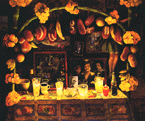|
|
|
| EJS
|
How has your work changed living in New York?
|
| EC
|
Well, it's been evolving but I guess it would have evolved had I stayed in
Mexico. However, being in New York has made me more conscious of certain
things that don't exist here. At first I tried to find
equivalents in New York to life in Mexico City but I soon realized that there
are very few such equivalents and I began to wonder why. One of the things
that was most striking was the difference between being poor in Mexico and
being poor in New York. Here, being poor is a shameful thing, perhaps that
comes from the Protestant ethic. But in Mexico people consider that it's
simply a question of bad luck. In the end God will even things out. In Mexico
the poor have a great sense of pride and this is reflected very much in
their aesthetic sense. In Mexico poor people must fight to not let themselves
become overwhelmed and swallowed up. This comes out in the fact that
anything becomes an excuse for beauty. There's a great decorative sense in
Mexico. I've become much aware of that being away and it's affected my
work. Another great difference is color. For example, the sorts of industrial
colors available in Mexico can't be bought here. My own paintings have
become brighter since I've been in New York. My earlier work was more
austere.
|
| EJS
|
I know that when you go to Mexico you take a lot of photographs. Do you
consider these photographs as works of art in themselves?
|
| EC
|
Well, not really. I don't have a great technique. Some turn out very well
but others don't. I don't consider myself a photographer. I really use my
photographs as a dictionary. I have many notebooks with photos in them and
when I want to paint a door or a pot I look through my notebooks at all the
details I've gathered in my photos.
|
| EJS
|
Could you talk about your methods of composition and technique?
|
| EC
|
The first thing is that my ideas for a painting-for its composition-come
to me in an instant. Sometimes I actually compose the objects in my studio
if I can- although I often can't. I don't do preparatory drawings for my
paintings. I think that this would actually be counterproductive. It would kill
the spontaneity. The first thing I do on the canvas is sketch
the composition-quickly put the elements in the
place that they eventually will be. When painting the picture I try to
reproduce the process that the object itself underwent in its own creation.
For example, if I'm going to paint things in a bag I paint the objects first and
then paint the bag around them. Or I paint a window frame and then after that
the windows themselves. Insofar as is possible, I try to recreate the real
life process. This is essential for me. I often try to find out exactly how
things were made so that I can paint them truthfully. I'm very sensitive to
the way things look and interact with each other-reflections, distortions,
etc. I am very concerned about placement-how the back of a surface
interacts with the front and the visual effects they produce.
|
| EJS
|
Your paintings have various sizes. Can you explain any differences in
concept between one size and another?
|
| EC
|
The size of a painting makes a big difference in its mood or
atmosphere. A small painting is very focused; it has its
own world within it whereas a big painting is more explosive. It's done to
have a greater impact from afar-so there are big differences that relate to
the size. Sometimes I work on a small and a large painting at the same time
to maintain a certain equilibrium. Each size painting is very exhausting to
do-but each in a different way. A large picture is filled with emotion. I'm in
a more agitated state when I paint them. In a certain sense the large works
are more conceptual. You're always concerned about how it will look from a
distance and you have to paint more indistinctly so that it will make sense
from far away. Brush strokes are much freer and the images have to be more
synthesized. A small painting is more like the work of an artisan. What will
be seen is exactly what you're painting. You are at the same distance as the
viewer will be.
|










